Many people use snake plants in their home decor…
… because they are attractive and require little water.
Snake plant care is also easy…
Hear it from Lily!
Oh how I love snake plants. You know why?
Simply because I don’t have to look after them 24/7…
They’re like this independent adult that can take care of themselves…
Well, aside from the external needs that I still have to supply them with…
Moreover, they don’t ask for much…
They only require basic houseplant care, which is available at home…
They would also provide me with all their benefits…
… without asking for anything in return!
The greatest houseplant indeed!
Let us get to know this functional houseplant…
The Snake Plant
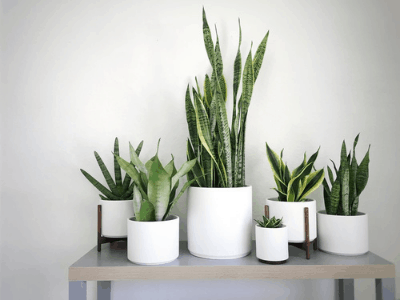
Snake plants are also known as mother-in-law’s tongue or sansevieria plants…
… and are low-maintenance houseplants.
They are highly resistant to pests…
… so even those with bad green thumbs will have a hard time killing them.
These Sansevieria come with thick, sword-shaped leaves…
… making the plants almost like artificial plants…
… plus their lack of branches makes them ideal for decorating small spaces.
Native to Asia and Africa, the Sansevieria also acts as an air purifier…
This plant is somewhat poisonous if ingested in big quantities…
and can induce swelling and tingling of the tongue.
It is recommended that children and pets do not consume this plant…
Although Sansevieria have been popular for home décor for quite some time…
… their popularity has grown steadily over time.
If you’re thinking about bringing this type of plant into your home,
…here’s how to care for it.
Types Of Snake Plants
These plants are distinguished from other plants by thick yet slender leaves…
… standing upright with yellowish-green or silver streaks.
They grow several feet tall, and do not require and excessive amount of watering…
There are several types of Sansevieria…
Twisted Sister
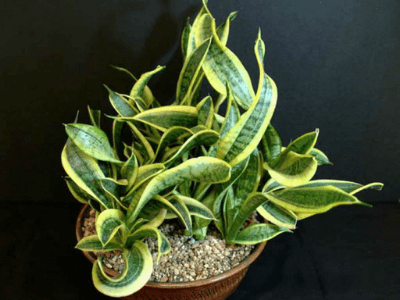
Known for its unique and curled leaves, the Twisted Sister snake plant is a favorite among interior designers…
It has striking silvery-green markings in the center of the leaves…
… and comes in many shades of gold and lime green.
Snake plants come in a variety of dwarf varieties that grow only 12 to 15 inches tall and add liveliness to any room…
This snake plant grows between 12 to 15 inches tall and belongs to the dwarf snake plant variety…
Golden Hahnii
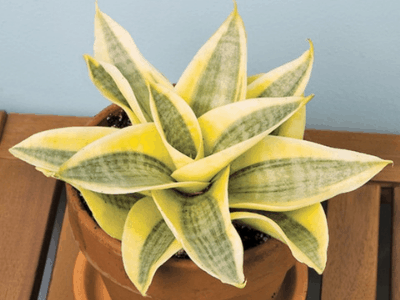
The Golden Hanhii snake plant is classified as a dwarf sansevieria plant…
Its leaves feature two shades of green horizontal markings, and they form in clusters, becoming leafy funnels…
The rosette pattern of this plant is visible from the top…
This plant only grows up to 12 inches high; to get the full effect, plant it in clumps…
This gives the plant its intricate design a better chance of showing…
Futura Robusta

Futura Robusta snake plants are also called evergreen sansevieria and the leaves have yellow, striped patterns…
They usually grow up to 24 inches tall. It thrives best in indoor conditions and does not require much water…
It benefits from occasional pruning to look its best…
Viper’s Bowstring
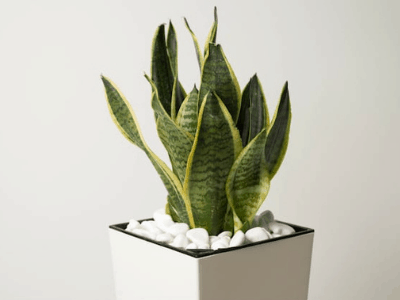
Snake plants are popular among indoor plant enthusiasts…
… because of their dark green leaves and classic yellow edges.
Their tall, stiff leaves complete the elegant look of the viper’s bowstring snake plant…
… which is perfect for a minimal black and white decor.
The leaves of this variety are about 2.5 inches wide and grow to about 35 inches tall…
Small tubular flowers bloom during summer or fall…
The plant has excellent filtration capabilities, so most people place it in their living room or bedroom…
In Chinese Feng Shui, snake plants are considered lucky…
It is a debatable fact that the snake plant is also beneficial by providing protective energy to the space, depending on the position it is placed. The pointed leaves can be used to shield against negative killing energies. Beside that, its leaves extends in an upward direction that is an auspicious representation of growth and positivism. In fact, a snake plant is not necessarily a bad Feng Shui as compared to dying one but it is the right placement that really matter.
Feng Shui Beginner
… so select this snake plant to have good energy in your home and a natural air purifier.
Snake Plant Care Basics
Use Free-Draining Soil Mix
When overwatered, Sansevieria will rot. To ensure that your plants don’t suffer from this problem…
… use a well-draining soil mix, such as one intended for succulents…
… which is resistant to becoming saturated.
The best type of pot for Sansevieria are terra cotta…
… which dries out the soil quicker than plastic.
Use pots with drainage holes on the bottom,
…your indoor plants will thank you….
Place Your Snake Plant in Indirect Light, and Keep It Warm

When growing a Sansevieria as a houseplant it does not need direct sunlight…
It can grow just as well, though slower, in low-light areas of your house…
However, if you want your Sansevieria to grow optimally, place it in an area with indirect, bright light…
Plants that grow best in warm environments should be placed…
… in an area with temperatures above 50°F or 10°C.
Protect the plant from drafty windows over the winter months…
Don’t Overwater
Sansevieria and other succulent plants are susceptible to root rot due to overwatering…
To prevent the problem, you must let the soil dry out between waterings…
A few inches of soil should be enough to verify whether it has dried out…
If it comes out dry, then go ahead and water…
On the other hand, if the soil comes out moist with dirt attached…
… then you might want to wait for a few more days before you water.
Alternatively, consider using a soil moisture meter…
The roots of your plant will grow deeper into the soil if you water from the bottom of the pot…
Water less often during the winter months…
Because your plant isn’t actively growing during this time…
… it needs less water than during spring and summer.
Propagate Your Snake Plant
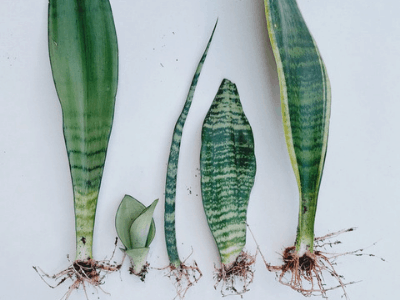
Sansevieria are quick growers in the right conditions. You may need to propagate them…
They are easy to propagate, and soon you will have a bunch of Sansevieria throughout your home…
You can even give some to family and friends…
If you want to grow Sansevieria, propagate them by cutting two to three inches of leaves…
Place these leaf cuttings about an inch deep in the soil and wait for them to grow…
Propagation is best done during springtime. However, newly propagated plants grow faster in summer…
Replace The Soil Every 8 – 12 Months
To avoid root rot, you can choose to replace your snake plant’s soil every eight to 12 months…
When transferring your plant, check to make sure the roots are not pressing against the pot…
You might want to get a larger pot if you detect that the roots aren’t having enough room to grow…
Get a new pot that is one to two inches wider only if the roots aren’t having enough room to expand…
You should also watch for newly emerging leaves that begin to wilt before they can grow…
If the older leaves begin to have health problems, your snake plant needs to be repotted…
Repotting snake plants every two to three years can keep them healthy and flourishing…
Prune Your Snake Plant when Needed
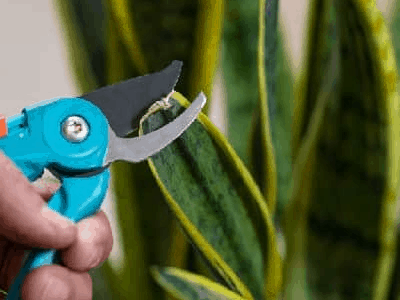
Plants with damaged leaves or overgrown stalks need to be pruned…
… and that’s a relatively simple process.
Just cut the damaged stalks off at the base using a sharp, clean plant knife…
It is best to slice plants as close to the root as possible…
If you notice that your plant leaves are dropping, you can pull the leaf out of the root and replant it…
If it is time to go, it will come out quickly…
Clean the Leaves
In addition to avoiding watering the leaves, test your plant’s health by using a soft cloth the top of the leaves…
Wipe off any accumulated dirt and dust, helping the plant show off its healthy glow…
Clean leaves also help the plant absorb more light…
Use Fertilizer
A high-quality, organic fertilizer can significantly boost the growth rate of snake plants…
While many indoor gardeners prefer to use compost instead of fertilizers…
… if you are just starting out with snake plants, start with commercial fertilizer.
The best way to fertilize your snake plants is to use an all-purpose organic fertilizer…
… available at most gardening stores or online.
Fertilizing them helps give them the extra love and boost they need…
Snake plants grow the most during warmer seasons…
… so fertilizing your plant once during spring and once again in the summer is recommended.
Snake plants are slow-growing…
Fertilizers encourage plant growth, but just like with water…
… you don’t want to over-fertilize your plants.
Fertilize only once every two seasons and don’t fertilize in the winter…
Watch Out for Snake Plant Care Warning Signs
Snake plants are tough and resilient, so most common problems can be easily fixed…
Watch out for any signs that your plant is not doing well and administer the right snake plant care…
- Yellowing snake plant leaves indicate overwatering. Snake plants need a thorough drying after watering and dead leaves should be removed as close to the base as possible. Keep your snake plant healthy by allowing the soil to dry out completely between waterings.
- Soft, mushy, discolored leaves are a sign of root rot. The roots of a healthy plant are yellow. Rotted roots are dark, odorous, and signify that the plant should be divided and planted in fresh soil. Replant the healthy leaves. Discard the unhealthy parts.
- Watch out for brown leaf tips. Snake plant leaves can turn brown if not watered properly, exposed to the sun, or exposed to cold temperatures. Even though snake plants are relatively easy to care for, you must still make necessary adjustments in their environment to keep them healthy.
- Leaning snake plants can have a few causes. If your plant leans to one side, it may need more sunlight or repotting. However, if the leaves appear to be about to collapse, you may have advanced root rot. Make sure the roots are healthy and make the necessary adjustments.
- Look out for discolored or damaged leaves. It is wise to shear off the unhealthy leaves. Watch out for their shape for a more natural appearance. Broken or cut tips will stop growing, but you can plant the damaged leaf back into the soil. It takes at least a year for new leaves to emerge.
Use Pest Control Solutions in Your Snake Plant Care If Needed

When mealybug and spider mites invade snake plants, they can be both irritating and controllable…
Once you’ve spritzed away with rubbing alcohol, these pesky pests will no longer bother your plants…
Organic, safe commercial pesticide solutions are also an alternative…
Spray more liberally with a soap and water mixture if you prefer a milder solution…
Continue spraying this solution until your plant is pest-free…
Another method of pest control benefits indoor plants includes neem oil and water mixed with compost…
… which is sprayed on the plants. Neem oil helps keep pests away naturally.
Benefits Of Proper Snake Plant Care
Filter Indoor Air
Snake plants are one of the few plants,
…that can turn carbon dioxide into oxygen,
…and they can also filter interior air.
Snake plants are fantastic for,
…maintaining healthy airflow and adding
…a splash of color to your house
These plants are capable of absorbing harmful toxins…
Formaldehyde, benzene, the amine trichloroacetate,
and a variety of other chemicals are among them.
Snake plants can also help to avoid allergies,
thanks to their ability to absorb toxins from the air.
Drought Resistance
It’s perfect for people who travel frequently or seldom come home…
Snake plants don’t need to be watered regularly…
You can keep them healthy even if you only water them once a month during the winter…
Aesthetically Pleasing and Symbolic
Since open concept interior design has become increasingly popular…
… snake plants can act as natural partition walls and brighten up corners.
They say this plant brings excellent luck to the home…
… and will no doubt clean the air as well as bring you good energy.
Indeed, it is a no-fuss, no-frills plant that will purify the air in your home and bring you good luck…
To sum it up…
Because snake plants can provide so many benefits…
… it’s no wonder they’ve become the most popular indoor plant.
If you want to care for your snake plant properly, remember that less is more…
It doesn’t matter how much water you give snake plants or how much light you provide them with…
They will continue to thrive even when you’re not paying close attention to them…
Snake plants add beauty, value, and convenience to any home…
Conclusion
If you still have questions on how to take care of a snake plant…
… you can comment down below or contact us!
We welcome any sharing of experiences and suggestions anytime!
Check out more of our posts like this one here!
I hope you can now take care your snake carefully and grow it big!
Have an awesome gardening journey!


